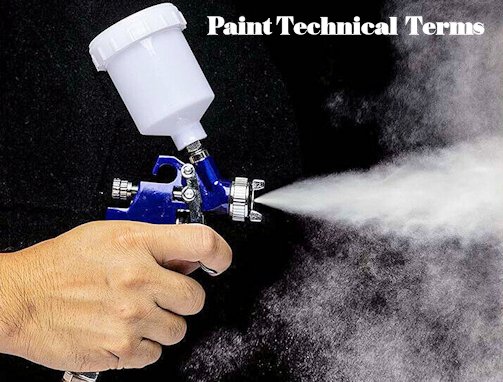Paint Technical terms A-G

The following are examples of technical terms related to paintwork and recommended for general use.
A
Adhesion
Separation resistance between paint and base.
Anti-sag
characteristic Characteristic of paint not to run/sag while painting vertical surfaces, including thick layers.
B
Bleeding
Penetration of paint materials. Chemical resistance Resistance of paint coat against attack or infiltration of chemicals, i.e. acids, strong solutions, industrial fall-out, natural (organic) fall-out, gases.
C
Clouding
In metallic painting, the uneven distribution of the metallic effect, giving components/particles in the paint.
Coating Collective
term for layers made of coating materials and applied to a base.
Coating material substance
A material which is not prefabricated and provides a coating. See also paint.
Coat thickness
A paint layer has no compactness in a physical sense but only a thickness.
Colour
The sensory perception transmitted by the eye. A colour is characterized by colour tone, brightness and saturation (fullness).
Colour tone
Characteristic which differentiates a chromatic colour (blue, green, red, etc.) from a non-chromatic (hueless) colour (black, white).
Complete drying capacity
complete drying, hard drying Attainment of operational hardness throughout the layer, where 'complete drying' applies more to physically and oxidatively drying (air dry) systems and 'hard drying' more to catalytically and poly-additively drying systems.
Consumption
The quantity of coating material required to provide an area of a given size under given conditions with a layer of given thickness when dry. Indication in kg/m2 or l/m2. See also effective coverage.
Corrosion protection
Sum total of measures for protecting metals, plastics and other materials against destruction by chemical and/or physical attack (aggressive media, weather, mechanical stresses).
Covering ability Ability of a pigmented material to cover the colour or differences in colour of
the base.
D
Drying.drying methods, drying stages
Transition of paint coat from a fluid to a solid state, caused by physical and/or chemical processes.Drying methods are, for example: air drying, heat drying (oven drying, baking or stoving) and radiation drying. Drying stages are: dust dry, tack free and thoroughly dry (fully dried).
Drying time
Period between application of paint and a drying condition determined by specified test conditions.
E
Effect
(paint finish)Visual appearance under similar light conditions of a paint finish with particles which are reflecting differently when looked at from different angles.
Effective coverage
Defined as the area of surface attained with the quantity of a coating material for one layer of certain thickness. Data in m2/l or m2/kg. See also consumption.
F
Flow structure
The general characteristic of paint in its liquid state to spread out smoothly onthe surface being applied to.
Filling capacity
Capacity of a paint to equalizc the unevenness of the base, which provides the optical effect of a particularly well painted surface (fullness).
G
Gloss Visual
appearance of various reflection of light on a paint finish — high gloss, satin gloss, etc.
Gloss retention
Characteristic of a paint finish to resist dulling, that is, of a paint finish dulling by usage, external influences, etc.
